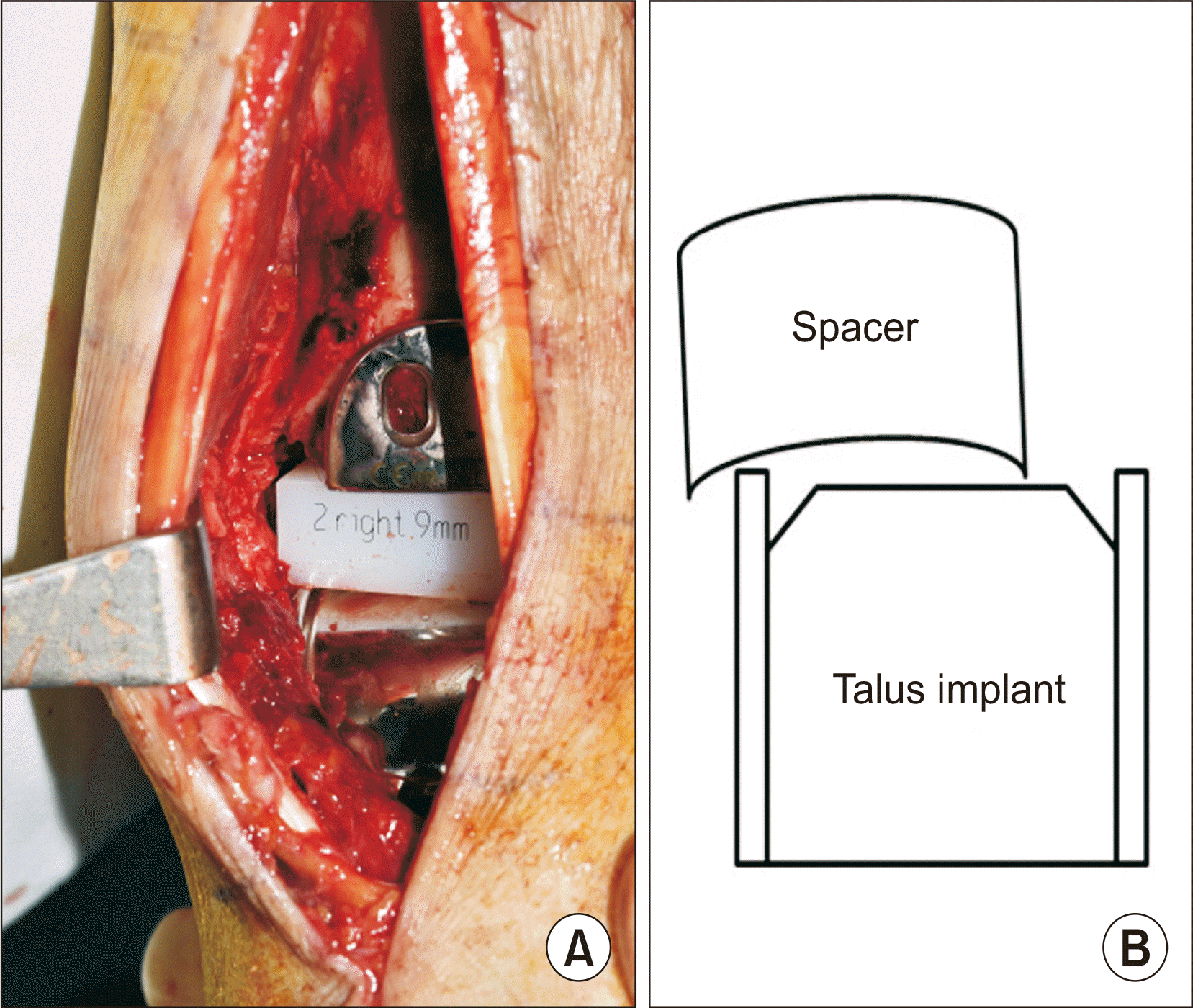1. Su EP, Kahn B, Figgie MP. Total ankle replacement in patients with rheumatoid arthritis. Clin Orthop Relat Res. 2004; (424):32–8. doi: 10.1097/01.blo.0000132181.46593.82. DOI:
10.1097/01.blo.0000132181.46593.82. PMID:
15241141.

2. Ng SY, Crevoisier X, Assal M. 2012; Total ankle replacement for rheumatoid arthritis of the ankle. Foot Ankle Clin. 17:555–64. doi: 10.1016/j.fcl.2012.08.004. DOI:
10.1016/j.fcl.2012.08.004. PMID:
23158370.

3. Wood PL, Crawford LA, Suneja R, Kenyon A. 2007; Total ankle replacement for rheumatoid ankle arthritis. Foot Ankle Clin. 12:497–508. viidoi: 10.1016/j.fcl.2007.05.002. DOI:
10.1016/j.fcl.2007.05.002. PMID:
17765841.

4. Cracchiolo A 3rd, Cimino WR, Lian G. 1992; Arthrodesis of the ankle in patients who have rheumatoid arthritis. J Bone Joint Surg Am. 74:903–9. DOI:
10.2106/00004623-199274060-00012. PMID:
1634581.

5. Glazebrook M, Daniels T, Younger A, Foote CJ, Penner M, Wing K, et al. 2008; Comparison of health-related quality of life between patients with end-stage ankle and hip arthrosis. J Bone Joint Surg Am. 90:499–505. doi: 10.2106/JBJS.F.01299. DOI:
10.2106/JBJS.F.01299. PMID:
18310699.

6. Lefrancois T, Younger A, Wing K, Penner MJ, Dryden P, Wong H, et al. 2017; A prospective study of four total ankle arthroplasty implants by non-designer investigators. J Bone Joint Surg Am. 99:342–8. doi: 10.2106/JBJS.16.00097. DOI:
10.2106/JBJS.16.00097. PMID:
28196036.

7. Stavrakis AI, SooHoo NF. 2016; Trends in complication rates following ankle arthrodesis and total ankle replacement. J Bone Joint Surg Am. 98:1453–8. doi: 10.2106/JBJS.15.01341. DOI:
10.2106/JBJS.15.01341. PMID:
27605689.

8. Daniels TR, Younger AS, Penner M, Wing K, Dryden PJ, Wong H, et al. 2014; Intermediate-term results of total ankle replacement and ankle arthrodesis: a COFAS multicenter study. J Bone Joint Surg Am. 96:135–42. doi: 10.2106/JBJS.L.01597. DOI:
10.2106/JBJS.L.01597. PMID:
24430413.
9. Gougoulias N, Khanna A, Maffulli N. 2010; How successful are current ankle replacements?: a systematic review of the literature. Clin Orthop Relat Res. 468:199–208. doi: 10.1007/s11999-009-0987-3. DOI:
10.1007/s11999-009-0987-3. PMID:
19618248. PMCID:
PMC2795846.

10. Brunner S, Barg A, Knupp M, Zwicky L, Kapron AL, Valderrabano V, et al. 2013; The Scandinavian total ankle replacement: long-term, eleven to fifteen-year, survivorship analysis of the prosthesis in seventy-two consecutive patients. J Bone Joint Surg Am. 95:711–8. doi: 10.2106/JBJS.K.01580. DOI:
10.2106/JBJS.K.01580. PMID:
23595069.
11. Mulcahy H, Chew FS. 2015; Current concepts in total ankle replacement for radiologists: complications. AJR Am J Roentgenol. 205:1244–50. doi: 10.2214/AJR.14.14171. DOI:
10.2214/AJR.14.14171. PMID:
26587931.

12. Scott AT, Nunley JA. 2009; Polyethylene fracture following STAR ankle arthroplasty: a report of three cases. Foot Ankle Int. 30:375–9. doi: 10.3113/FAI.2009.0375. DOI:
10.3113/FAI.2009.0375. PMID:
19356364.

13. Wood PL, Deakin S. 2003; Total ankle replacement. The results in 200 ankles. J Bone Joint Surg Br. 85:334–41. doi: 10.1302/0301-620x.85b3.13849. DOI:
10.1302/0301-620X.85B3.13849. PMID:
12729104.
14. Doets HC, Brand R, Nelissen RG. 2006; Total ankle arthroplasty in inflammatory joint disease with use of two mobile-bearing designs. J Bone Joint Surg Am. 88:1272–84. doi: 10.2106/JBJS.E.00414. DOI:
10.2106/JBJS.E.00414. PMID:
16757761.

15. Doets HC, van der Plaat LW, Klein JP. 2008; Medial malleolar osteotomy for the correction of varus deformity during total ankle arthroplasty: results in 15 ankles. Foot Ankle Int. 29:171–7. doi: 10.3113/FAI.2008.0171. DOI:
10.3113/FAI.2008.0171. PMID:
18315972.

16. Beumer A, Valstar ER, Garling EH, Niesing R, Ginai AZ, Ranstam J, et al. 2006; Effects of ligament sectioning on the kinematics of the distal tibiofibular syndesmosis: a radiostereometric study of 10 cadaveric specimens based on presumed trauma mechanisms with suggestions for treatment. Acta Orthop. 77:531–40. doi: 10.1080/17453670610012557. DOI:
10.1080/17453670610012557. PMID:
16819696.

17. Buechel FF Jr, Pappas MJ. 2003; Ten-year evaluation of cementless Buechel-Pappas meniscal bearing total ankle replacement. Foot Ankle Int. 24:462–72. doi: 10.1177/107110070302400603. DOI:
10.1177/107110070302400603. PMID:
12854666.

18. Mujukian A, Ho NC, Day MJ, Ebramzadeh E, Sangiorgio SN. 2020; A systematic review of unsystematic total ankle replacement wear evaluations. JBJS Rev. 8:e0091. doi: 10.2106/JBJS.RVW.19.00091. DOI:
10.2106/JBJS.RVW.19.00091. PMID:
32149932.


